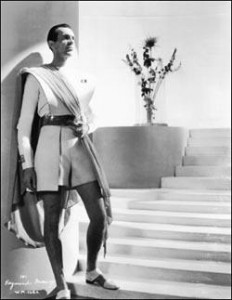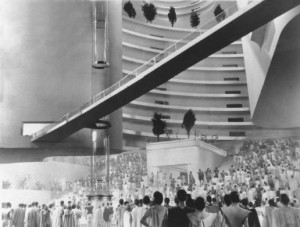 H. G. Wells participated directly in this pioneer Science Fiction film of 1936. The film is visually fascinating. No expense or effort was spared in it’s art direction, to put across the 1930’s vision of the future, with it’s moving sidewalks and colossal shoulder-pads. It is also imbued with the totalitarian atmosphere of that era. Wells envisions a world war coming (he places it in 1940), which drags on for decades until the world is reduced to barbarism. Then a technocratic force of scientist-airmen takes over the world and builds it into a “utopia”. It is all white walls and glass tubing. One character explains that their savage ancestors lived “half-out-doors” before they learned the superiority of artificial light. Finally, in 2036 AD, an expedition is sent to the Moon, despite the attempt of an “anti-progress” artist to sabotage the project.
H. G. Wells participated directly in this pioneer Science Fiction film of 1936. The film is visually fascinating. No expense or effort was spared in it’s art direction, to put across the 1930’s vision of the future, with it’s moving sidewalks and colossal shoulder-pads. It is also imbued with the totalitarian atmosphere of that era. Wells envisions a world war coming (he places it in 1940), which drags on for decades until the world is reduced to barbarism. Then a technocratic force of scientist-airmen takes over the world and builds it into a “utopia”. It is all white walls and glass tubing. One character explains that their savage ancestors lived “half-out-doors” before they learned the superiority of artificial light. Finally, in 2036 AD, an expedition is sent to the Moon, despite the attempt of an “anti-progress” artist to sabotage the project.
The central character, Oswald Cabal, played by Raymond Massey, gives stiff-jawed speeches like this: “Rest enough for the individual man — too much, and too soon — and we call it death. But for Man, no rest and no ending. He must go on, conquest beyond conquest. First this little planet with its winds and ways, and then all the laws of mind and matter that restrain him. Then the planets about him and at last out across immensity to the stars. And when he has conquered all the deeps of space and all the mysteries of time, still he will be beginning.”
I watched this with a little irony. The house that Raymond Massey grew up is only a hundred metres from my apartment. Massey led a fascinating life (he managed to be severely wounded in action in both world wars, and his brother was Governor General of Canada). The family home is now a steak house, and I had a birthday dinner with my mother there, a week ago. Much of the original furniture is still there.
0 Comments.